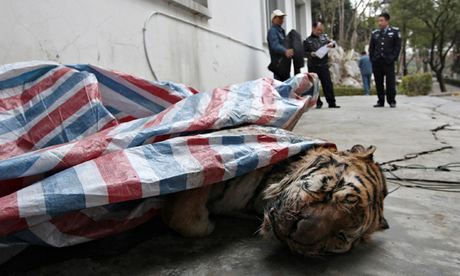
Police in the port city of Zhanjiang, in the southern province of Guangdong, seized a freshly slaughtered tiger and multiple tiger products in a raid this month, said the Nanfang Daily, the mouthpiece of the provincial Communist Party.
Local officials and prominent businesspeople gathered to watch the tigers being killed as "eye-openers" to show off their social stature, it said. Video footage of a killing two years ago showed the tiger, kept in an iron cage, having an electrified iron mass prodded into its mouth with a wooden stick and passing out after being electrocuted for more than 10 seconds, the paper said.
An experienced cattle or pig slaughterer is normally hired to butcher the carcass, it said, adding that tiger bones sold for an average of 14,000 yuan (£1,360) a kilo while the meat fetched 1,000 yuan a kilo.
Police said a butcher - who jumped to his death while trying to escape arrest in a raid - had killed more than 10 animals, the report on Wednesday added. "The tigers were probably anaesthetised for transport. But buyers would check them to make sure that they were alive before the killing," it quoted an unnamed source as saying.
Most buyers of the meat and bones were business owners who would then give them to officials as gifts, the paper said.
Tiger bones have long been an ingredient of traditional Chinese medicine, for a supposed capacity to strengthen the human body. While they have been removed from official ingredient lists, there is still deman.
Decades of trafficking and habitat destruction have cut tiger numbers from 100,000 a century ago to about 3,000, according to the International Union for the Conservation of Nature's Red List of threatened species.
Source: Agence France-Presse



Reader Comments